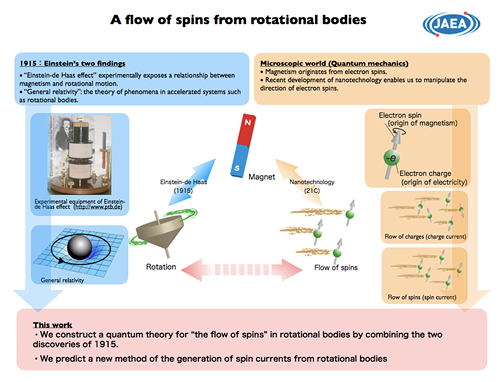A flow of spins from rotational bodiesFeb. 15, 2011 Joint Research group of JAEA, Tohoku University, and Kyoto University has found a new method for the generation of spin current from rotational bodies. In 1915, Albert Einstein made two important discoveries, independently, which are known as the general relativity and the Einstein-de Haas effect. The general relativity describes phenomena in accelerated systems such as rotating bodies. The Einstein-de Haas effect reveals a relationship between magnetism and rotational motion. The quantum mechanics, the theory for the microscopic world, was established in 1926, telling us that the origin of magnetism is electron spin. Recent exciting progress of nanotechnology enables us to manipulate the flow of electron spins, i.e. �spin current�. The interplay of spin current and magnets has been well studied for nano-device applications. In spite of the Einstein�s discoveries, rotational motion has not been utilized for controlling the �spin current�. In this research, we construct a quantum theory for the flow of spins in rotational bodies by combining the two Einstein�s discoveries of 1915. A new method of the generation of spin current from rotational bodies is predicted. This work has been published in the American Physical Society Journal �Physical Review Letters� (online, February 17, 2011) as �PRL Editors� suggestion�. |




